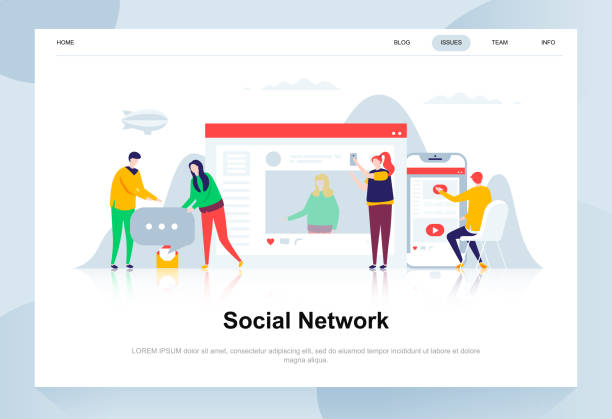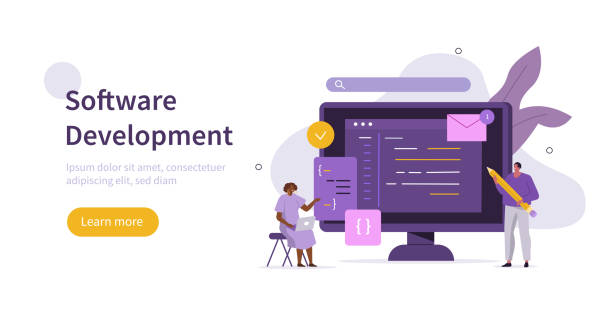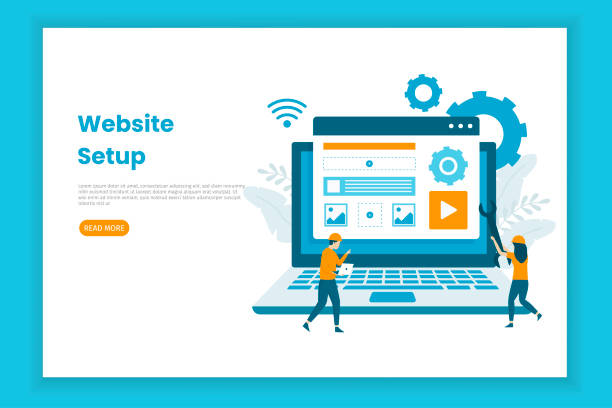An Introduction to Secure Website Design and Its Fundamental Importance

In today’s digital world, which grows more complex every day, secure website design is not an option, but an undeniable necessity.
Websites have become the beating heart of businesses, communication platforms, and information sources, and protecting user data and system integrity is of paramount importance.
The main goal of #secure_website_design is to create a reliable and resilient online environment against all types of #cyber_threats.
This approach goes beyond simply installing an SSL certificate and includes a set of preventive and defensive measures at all stages of website development and maintenance.
From selecting the right architecture and secure frameworks to secure coding and proper configuration management, every step must be taken with a security mindset.
This process not only protects sensitive customer and business information but also builds user trust and significantly contributes to brand reputation.
A website that is attacked may face huge financial losses, data loss, damage to reputation, and legal penalties.
Therefore, investing in website security is, in fact, an investment in long-term stability and success in the virtual space.
Development teams must receive the necessary training in #web_security_principles and use up-to-date tools and methods to identify and resolve vulnerabilities.
This section serves as an explanatory and educational introduction, setting the general framework for our discussion on comprehensive and effective approaches to cybersecurity and how to implement it in modern website design.
Is your current e-commerce website design not generating the sales you expect?
RasaWeb specializes in professional e-commerce website design!
✅ Attractive and user-friendly site aimed at increasing sales
✅ High speed and security for an ideal shopping experience⚡ Get a free consultation for online store design with RasaWeb!
Common Web Security Threats and How to Identify Them

Understanding common threats and vulnerabilities is the first step in secure website design and developing resilient websites.
Cyber attacks are constantly evolving, and cybercriminals use more sophisticated methods for unauthorized access to data, system destruction, or disruption of website operations.
Common threats include SQL Injection, Cross-Site Scripting (XSS), Cross-Site Request Forgery (CSRF), and DDoS attacks.
Each of these attacks has different mechanisms and objectives, but all can have catastrophic consequences for businesses and users.
For example, SQL Injection attacks aim to manipulate databases, allowing attackers to access sensitive information or even alter the database structure.
In XSS attacks, malicious code is injected into web pages to steal user information or perform unauthorized activities.
Identifying these vulnerabilities requires specialized knowledge and the use of appropriate tools.
Detailed source code analysis, regular penetration testing, and the use of automated security scanners are key methods for discovering weaknesses.
Additionally, the OWASP Top 10 list is an excellent resource for understanding the most common and critical web security vulnerabilities that every developer should be familiar with.
Continuous monitoring of server logs and unusual activities can also reveal early signs of attacks and allow for rapid response.
This section specifically and analytically deep dives into various types of attacks and explains methods for identifying them.
Implementing Best Practices in Secure Website Coding

The core of secure website design lies in the quality and security of coding.
Insecure code is a gateway for attackers.
Therefore, adhering to best practices at all stages of software development is of particular importance.
The first and most crucial principle is strict and thorough validation of user inputs.
Any data received from the user, whether through forms, URLs, or cookies, must be sanitized and validated before processing or storage to prevent attacks such as SQL Injection and XSS.
Using Prepared Statements in database interactions is an effective solution against SQL injection.
The second principle is proper error management and secure logging.
System error information should not be displayed to the user, as it may contain sensitive information for an attacker.
Instead, errors should be logged internally, and only essential information should be shown to the user.
Furthermore, using secure and up-to-date frameworks and libraries, instead of reinventing the wheel, can significantly enhance code security, as these tools are usually reviewed by a large community of developers and their vulnerabilities are patched.
Studying web security guides published by experts can also be very helpful.
In the following, to clarify some key points in secure coding, pay attention to the table below, which provides a summary of essential actions:
| Security Action | Explanation | Importance |
|---|---|---|
| Input Validation | Thorough cleaning and checking of all data received from the user. | Prevention of SQL Injection and XSS. |
| Use of Prepared Statements | Separating SQL logic from data. | Protection against SQL injection. |
| Proper Error Handling | Do not display sensitive error information to the user. | Prevention of system information disclosure. |
| Library Updates | Using the latest versions of frameworks and libraries. | Fixing known vulnerabilities. |
These guidelines help developers adopt preventive approaches for safer coding and contribute to increasing website security.
The Importance of Data Encryption and User Privacy Protection

In the digital age, secure website design without attention to data encryption and user privacy protection would be incomplete and meaningless.
Data transfer and storage online are always accompanied by risks, including eavesdropping, manipulation, or theft of information.
For this reason, encryption acts as a vital defensive layer, ensuring that information, even if unauthorized access occurs, remains unreadable to attackers.
The use of secure protocols such as SSL/TLS (HTTPS) for all web communications is a global standard.
These protocols encrypt data in transit between the user’s browser and the server, preventing attacks such as Man-in-the-Middle.
Beyond in-transit encryption, data at rest encryption is also of paramount importance.
This includes encrypting databases, uploaded files, and any sensitive information stored on the server.
Even if an attacker gains access to the server, they will not be able to read this information without the decryption key.
In addition to technical aspects, compliance with data privacy regulations such as GDPR in Europe or similar laws in other countries is mandatory for any website that collects and processes user information.
These regulations strengthen user rights regarding their personal data and oblige organizations to adopt appropriate security measures and transparency in collecting and using information.
This explanatory approach not only clarifies technical principles but also highlights the legal and ethical implications of data protection, assisting developers in creating fully secure websites.
Websites must have clear and understandable privacy policies so that users are aware of how their information is collected and used.
Is your e-commerce site ready to attract maximum customers and increase sales? RasaWeb transforms your online business with modern and efficient e-commerce website designs.
✅ Increased speed and improved SEO
✅ Excellent user experience on mobile and desktop⚡ Get a free e-commerce website design consultation from RasaWeb!
Principles of Strong Authentication and Access Authorization

One of the main pillars of secure website design is the implementation of robust authentication (Authentication) and authorization (Authorization) mechanisms.
Authentication refers to verifying the user’s identity (e.g., with username and password) and authorization refers to determining the user’s access level to different website resources after identity verification.
Weakness in either of these two areas can lead to unauthorized access and security breaches.
Using strong and complex passwords that include a combination of uppercase and lowercase letters, numbers, and symbols is the first step.
However, relying solely on passwords is not enough.
Implementing two-factor authentication (Two-Factor Authentication – 2FA) or multi-factor authentication (Multi-Factor Authentication – MFA) is strongly recommended.
In this method, in addition to the password, the user must use another method of identity verification such as an SMS code, fingerprint, or security token.
This prevents attacker access even if the user’s password is stolen.
From an educational and specialized perspective, access authorization systems should be designed based on the Principle of Least Privilege; meaning that each user or system should only have access to the minimum resources and operations required to perform their task.
Implementing Role-Based Access Control (RBAC), where access is granted based on defined roles (e.g., administrator, editor, regular user), helps manage access more efficiently and securely.
NIST guidelines on digital identity are also an excellent resource for a deeper understanding of these concepts.
This approach ensures that each user only has access to what they are authorized for and prevents internal and external misuse, ultimately contributing to website security stability.
The Role of Security Audits and Regular Updates

Even the best secure website design can become vulnerable to new threats if it is not continuously monitored and updated.
Regular security audits, including Penetration Testing and Vulnerability Scanning, are vital tools for discovering hidden weaknesses in a website.
Penetration testing is performed by security experts who simulate real attacks, attempting to discover vulnerabilities before actual attackers do.
These reports provide valuable insights for improving security.
Additionally, regular software updates for all website components, including Content Management System (CMS), plugins, frameworks, operating system, and web server, are essential.
Software developers constantly identify security vulnerabilities and fix them by releasing patches and updates.
Failure to update promptly can expose the website to known attacks, as attackers exploit publicly disclosed vulnerabilities.
Cybersecurity news regularly publishes information about new vulnerabilities and relevant patches, which is essential for every website security manager to follow.
This news and guidance section emphasizes the importance of the software security lifecycle and demonstrates that security is a continuous process, not a one-time event.
Ultimately, adhering to these audits and updates ensures the website’s stability and resilience against new threats.
Data Recovery Solutions and Emergency Backup

Even with the best secure website design approaches, the probability of unforeseen incidents such as successful cyber attacks, hardware failures, or natural disasters never reaches zero.
In such circumstances, having a robust plan for Data Recovery and an Emergency Backup (Disaster Recovery Plan) is crucial.
Regular and automatic backup of all website data, including databases, code files, uploaded content, and configurations, is the first step.
These backups should be performed daily, weekly, and monthly and stored in secure locations, preferably separate from the main server (e.g., in the cloud or offline servers).
The type of backup (full, incremental, differential) and its frequency should be determined based on the rate of data changes and the business’s tolerance for data loss.
In addition to backups, having a Disaster Recovery Plan (DRP) is essential.
This plan should include detailed steps for recovering systems and data after a major incident.
This involves defining responsibilities, required tools, the order of system recovery, and regular tests to ensure the plan’s effectiveness.
Periodic testing of the recovery process is vital to ensure that teams are prepared and the process runs smoothly in the event of a real incident.
This section, in an instructive and specialized manner, emphasizes the importance of preparing for worst-case scenarios and highlights its role in maintaining website stability and security.
To better understand data recovery planning, review the table below:
| Action | Explanation | Goal |
|---|---|---|
| Regular Backup | Making periodic copies of all data. | Preventing data loss. |
| Off-site Storage | Keeping backup copies in a location separate from the main server. | Protection against local disasters. |
| Disaster Recovery Plan (DRP) | Documenting detailed steps for system recovery after an incident. | Reducing downtime and damage. |
| Recovery Testing | Simulating the recovery process periodically. | Ensuring DRP effectiveness and currency. |
Having a Disaster Recovery Plan and reliable backup is an integral part of a comprehensive security strategy.
User Education and Awareness Against Threats

No matter how advanced the technologies used in secure website design, the human factor can ultimately act as the most vulnerable link in the security chain.
Phishing, social engineering, and the use of weak passwords are among the most common ways attackers penetrate systems through users.
Therefore, educating users and increasing their awareness about cyber threats is an inseparable part of a comprehensive security strategy.
These trainings should be provided continuously and engagingly so that users can recognize the signs of phishing attacks, avoid opening suspicious emails, not click on unknown links, and not download unsafe attachments.
Creating a security culture among users means encouraging them to use strong and unique passwords for each service, enable two-factor authentication, and report any suspicious activity.
You can increase user awareness through #infographics, #short_videos, and #phishing_attack_simulation_exercises.
The entertaining and educational part of this area can include friendly competitions focused on identifying attacks or providing “security tips of the week”.
Imagine designing a small game where users have to distinguish phishing emails from real ones; this method can make the learning experience sweeter for them.
Ultimately, every website that interacts with users has a responsibility to educate and empower them to protect their own security and the system’s.
This interaction not only helps to counter phishing but also leads to the overall strengthening of website security against attacks targeting users.
Do you dream of a thriving online store but don’t know where to start?
RasaWeb is your comprehensive e-commerce website design solution.
✅ Attractive and user-friendly design
✅ Increased sales and revenue⚡ Get a free consultation
Emerging Trends in Web Security and Future Preparedness

The world of secure website design and cybersecurity is constantly evolving.
With the emergence of new technologies such as Artificial Intelligence (AI), Blockchain, Serverless Computing, and Microservices architectures, security threats are also becoming more complex and diverse.
Therefore, to maintain website security in the future, we need to understand and prepare for emerging trends in web security.
Artificial intelligence is increasingly used in anomaly detection and cyber attacks, but at the same time, it can also be exploited by attackers to carry out more advanced attacks.
This is an important and thought-provoking question: how can we harness the power of AI for defense while preventing AI-driven attacks?
Serverless development, despite its many advantages, has its own security challenges, as security responsibility is shared between the service provider and the developer.
The concept of “Zero Trust”, which emphasizes not trusting any user or device, even within the network, is becoming a new standard in security architectures.
This analytical and questioning approach helps us go beyond traditional defense.
Blockchain, with its unique features of distribution and immutability of data, also has great potential to enhance security in areas such as authentication and digital identity management.
Companies and developers must continuously research these new trends, invest in emerging technologies, and acquire the necessary skills for the future of cybersecurity to design and maintain websites with lasting security.
The Future of Secure Web Development and New Perspectives

The future of secure website design focuses not only on addressing existing vulnerabilities but also on anticipating and preparing for unknown threats and future technologies.
The future outlook for secure web development is moving towards deeper integration of security at all stages of the Software Development Life Cycle (SDLC), often known as DevSecOps.
In this approach, security begins from the design and planning phase and is continuously considered throughout the coding, testing, deployment, and maintenance stages.
This means moving from “security as a feature” to “security as a culture”.
Future developers must be specialists not only in coding but also in security principles and offensive thinking to identify and resolve vulnerabilities before they become critical weaknesses.
Automation will play a key role in this vision, with tools that automatically scan code for vulnerabilities, apply secure configurations, and even perform initial incident responses.
Additionally, attention to Privacy by Design, where privacy principles are incorporated into system design from the outset, will become increasingly important.
International cooperation and threat information sharing will also be essential to combat global attacks.
This analytical section shows how DevSecOps and continuous security will revolutionize the web development framework and how developing fully secure websites will become an industry standard.
This paradigm shift ensures that future websites are built with the highest levels of security in mind from the very beginning.
Frequently Asked Questions
| Question | Answer |
|---|---|
| 1. What does secure website design mean? | Secure website design means creating a website that is resistant to cyber attacks and protects user and server information. |
| 2. Why is security important in website design? | To prevent data breaches, protect user privacy, maintain user trust, and avoid financial and reputational losses. |
| 3. What are the most common web vulnerabilities? | SQL Injection, Cross-Site Scripting (XSS), Cross-Site Request Forgery (CSRF), Broken Authentication, and Security Misconfiguration. |
| 4. How can SQL Injection be prevented? | By using Prepared Statements / Parameterized Queries, ORMs, and Input Validation. |
| 5. What is the role of HTTPS and SSL/TLS in website security? | HTTPS, using the SSL/TLS protocol, encrypts communication between the user’s browser and the server, preventing eavesdropping and data manipulation. |
| 6. What actions should be taken to prevent XSS attacks? | Input validation, Output Encoding to prevent malicious code execution, and using Content Security Policy (CSP). |
| 7. What does a strong password policy include? | Enforcing long passwords, a combination of uppercase and lowercase letters, numbers, and special characters, and preventing reuse. |
| 8. How does two-factor authentication (2FA) help security? | Even if the user’s password is compromised, the attacker cannot access the account without access to the second authentication factor (such as an SMS code or app). |
| 9. What is a Web Application Firewall (WAF) and what is its use? | A WAF is a firewall that monitors and filters HTTP traffic between a web application and the internet to prevent common web attacks such as SQL injection and XSS. |
| 10. Why are regular software and library updates important? | Updates often include security patches to fix discovered vulnerabilities. Failure to update can expose the site to new attacks. |
And other services of RasaWeb advertising agency in the field of advertising
Smart SEO: An effective tool for user interaction with the help of custom programming.
Smart Marketing Automation: An innovative platform for improving campaign management with marketing automation.
Smart Customer Journey Map: A fast and efficient solution for increasing site visits with a focus on SEO-driven content strategy.
Smart Google Ads: Revolutionize click-through rates with the help of an SEO-driven content strategy.
Smart Digital Branding: A fast and efficient solution for increasing click-through rates with a focus on Google advertising management.
And over hundreds of other services in the field of internet advertising, advertising consultation, and organizational solutions
Internet Advertising | Advertising Strategy | Advertorials
Resources
Security in Website Design
User Data Protection
Key Tips for a Secure Website
Website Security Checklist
? Are you ready to transform your business in the digital space? RasaWeb Aafarin Digital Marketing Agency provides innovative and comprehensive solutions including professional SEO, strategic social media management, and responsive website design, paving your way to success.
📍 Tehran, Mirdamad Street, next to Central Bank, Kazeroun Jonoubi Alley, Ramin Alley No. 6



